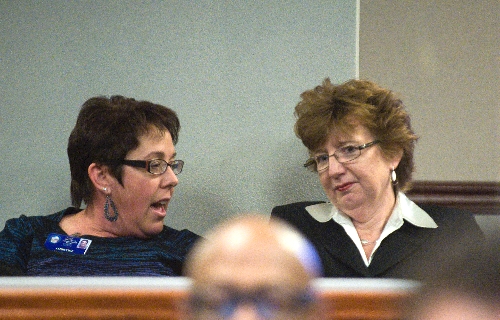District can avoid mass teacher layoffs, official says
CARSON CITY -- The Clark County School District might be able to avoid mass teacher layoffs, even with the 6.9 percent reduction in state support that came out of the Legislature's special session on Sunday, an administrator said.
Joyce Haldeman, the district's associate superintendent of government relations, could not provide figures on potential teacher layoffs but said the number would not be many if teachers union officials would agree to salary reductions of 2 percent to 4 percent.
"We have talked about the need for a 'shared sacrifice,'" Haldeman said. "We could save many jobs if they do that."
The 6.9 percent state funding reduction to education agreed on by Gov. Jim Gibbons and the Legislature represents a loss of $117 million to the K-12 system and a loss of $46 million to higher education. The Clark County School District expects to receive about $90 million less in state funding through June 30, 2011.
"It is not pretty," Haldeman said. "But under the circumstances, I don't know what else they could have done."
Earlier in the special session, Clark County Superintendent Walt Rulffes warned that more than 2,300 district teachers faced layoffs if the 10 percent reduction in state support proposed by Gibbons was approved.
The position of the Nevada State Education Association, an umbrella organization for local teachers unions, has been that salary concessions must be bargained. The association wants to review all sources of school revenue to determine whether other funds could be used to avoid layoffs or pay cuts.
Haldeman said the district is looking at laying off 100 of its 1,340 administrators and shortening the school year by up to four days. Classroom time for students would remain at 180 days, but some of the four training days teachers receive would be eliminated.
Chancellor Dan Klaich said the $46 million reduction to higher education funding will be discussed Thursday and Friday at a Board of Regents meeting in Las Vegas. He will request that cuts be spread "proportionately" among the colleges and universities.
In April, he expects college and university presidents to report to regents what will be cut. Some programs will be eliminated, and professors and staff members will be laid off, he said.
Legislators agreed to increase class-size averages in grades one to three by two students, which saves about $20 million, and to allow schools to use a $47 million state textbook fund for other costs.
Also, the Legislature took $25 million from a Clark County School District capital improvement bond fund. The money is to be used to reduce teacher layoffs.
State support accounts for about half of public school funding and one-third of higher education funding. When all funds, including local and federal revenues, are counted, the reduction facing the K-12 system is about 3 percent. For higher education, it's about 4 percent.
Klaich doesn't want faculty members and students "thinking everything is OK" based on what happened this weekend.
"We leave Carson City saying thank you Legislature, thank you governor, but the real cliff comes next February. That is when the tough decisions start," he said.
When legislators return to Carson City for their next regular session in February 2011, the state budget shortfall they face probably will be $3.4 billion, said state Senate Majority Leader Steven Horsford, D-Las Vegas.
Horsford said lawmakers then will have to decide whether to make even deeper cuts or raise taxes at a time when the economy might still be declining.
Contact Capital Bureau Chief Ed Vogel at evogel@reviewjournal.com or 775-687-3901.






















